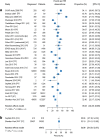Frequency and mortality of septic shock in Europe and North America: a systematic review and meta-analysis
- PMID: 31151462
- PMCID: PMC6545004
- DOI: 10.1186/s13054-019-2478-6
Frequency and mortality of septic shock in Europe and North America: a systematic review and meta-analysis
Abstract
Background: Septic shock is the most severe form of sepsis, in which profound underlying abnormalities in circulatory and cellular/metabolic parameters lead to substantially increased mortality. A clear understanding and up-to-date assessment of the burden and epidemiology of septic shock are needed to help guide resource allocation and thus ultimately improve patient care. The aim of this systematic review and meta-analysis was therefore to provide a recent evaluation of the frequency of septic shock in intensive care units (ICUs) and associated ICU and hospital mortality.
Methods: We searched MEDLINE, Embase, and the Cochrane Library from 1 January 2005 to 20 February 2018 for observational studies that reported on the frequency and mortality of septic shock. Four reviewers independently selected studies and extracted data. Disagreements were resolved via consensus. Random effects meta-analyses were performed to estimate pooled frequency of septic shock diagnosed at admission and during the ICU stay and to estimate septic shock mortality in the ICU, hospital, and at 28 or 30 days.
Results: The literature search identified 6291 records of which 71 articles met the inclusion criteria. The frequency of septic shock was estimated at 10.4% (95% CI 5.9 to 16.1%) in studies reporting values for patients diagnosed at ICU admission and at 8.3% (95% CI 6.1 to 10.7%) in studies reporting values for patients diagnosed at any time during the ICU stay. ICU mortality was 37.3% (95% CI 31.5 to 43.5%), hospital mortality 39.0% (95% CI 34.4 to 43.9%), and 28-/30-day mortality 36.7% (95% CI 32.8 to 40.8%). Significant between-study heterogeneity was observed.
Conclusions: Our literature review reaffirms the continued common occurrence of septic shock and estimates a high mortality of around 38%. The high level of heterogeneity observed in this review may be driven by variability in defining and applying the diagnostic criteria, as well as differences in treatment and care across settings and countries.
Keywords: Heterogeneity; Intensive care; Outcome; Sepsis; Sepsis definition.
Conflict of interest statement
JLV is the Editor-in-Chief of Critical Care. He has no other conflicts of interest to declare.
SD declares no competing interests.
GJ, EO, and KKC were employees of PHMR Ltd. when this work was performed. PHMR Ltd. was contracted by Ferring Pharmaceuticals to perform this systematic review and meta-analysis.
Figures





References
Publication types
MeSH terms
LinkOut - more resources
Full Text Sources
Other Literature Sources
Medical
Miscellaneous

